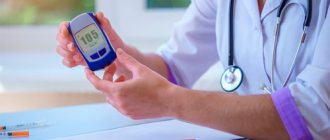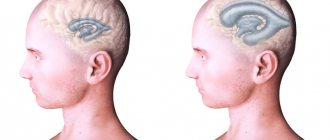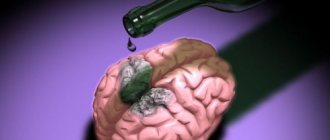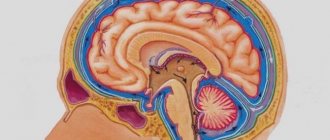Causes
Mixed encephalopathy is a polyetiological condition. The pathological process is triggered by several factors at once, often mutually exacerbating each other. The development of the disease is caused by:
- Cerebral circulation disorders. The most common cause, detected in most cases. Encephalopathy occurs with atherosclerosis, hypertension, symptomatic hypertension, congenital anomalies of cerebral vessels, aneurysms, and transient stroke.
- Dysmetabolic processes. Accompanying metabolic disorders and endocrine diseases. Most often, diabetes mellitus and thyroid diseases are identified on the list of etiofactors.
- Consequences of TBI. The most significant role is played by severe traumatic brain injuries (brain contusions, fractures of the vault and base of the skull, intracranial, subdural and epidural hematomas, crushing of the brain matter). Sometimes the disease develops against the background of repeated concussions.
- Chronic hypoxia. It is found in severe bronchial asthma, obstructive pulmonary disease, and after resection interventions.
- Consequences of strokes. Ischemia or hemorrhage leads to neuronal death with subsequent neurological deficits. Encephalopathy is especially often detected in patients with severe pyramidal insufficiency.
- Conditions after operations. The risk group includes patients who have undergone brain surgery for injuries, tumors, abscesses, intracranial hypertension, etc.
- Intoxication. The pathology is diagnosed in persons suffering from drug addiction and alcoholism, observed after poisoning with drugs and carbon monoxide, and in some occupational diseases.
Read also
Vegetative-vascular dystonia
Vegetative-vascular dystonia is a dysregulation of the autonomic nervous system, which manifests itself in the form of various clinical symptoms.
This disease is diagnosed at different times… Read more
Hemorrhagic stroke
Hemorrhagic stroke is a type of acute cerebrovascular accident, which is characterized by the effusion of blood into the brain substance with the development of neurological deficit, often leading...
More details
Swelling of the legs
Causes of Swelling in the Legs The legs are common sites for swelling due to the effect of gravity on the fluids in the human body. However, fluid retention is not the only cause of leg swelling. Injuries...
More details
Alzheimer's disease
47,000,000 people suffer from dementia in the world. Doctors call Alzheimer's disease the most common cause of dementia. Alzheimer's disease is a progressive neurodegenerative disease accompanied by...
More details
Atherosclerosis
What is atherosclerosis Atherosclerosis is a narrowing of the arteries caused by the formation of plaque. As a person gets older, fat and cholesterol can accumulate in the arteries and form plaque. Accumulation…
More details
Classification
For the convenience of determining treatment tactics and prognosis in clinical practice, 3 stages of pathology are distinguished, however, this division is quite arbitrary:
- First. There are no obvious symptoms. Changes are confirmed only with the help of additional techniques and are discovered by chance during a routine examination.
- Second. Neurological and mental disorders are mild or moderate. Characterized by the inconstancy of manifestations, which either decrease or increase.
- Third. Severe disorders are noted, leading to irreversible personality changes, disability, and the need for outside care.
Symptoms
Chronic course is more common. The clinical picture unfolds gradually, the first symptoms often go unnoticed. Initially, there are disturbances of attention, decreased mental performance, increased fatigue, difficulties in assimilating new information or trying to remember already known data. A person becomes less flexible and has difficulty switching from one type of activity to another. Emotional lability is typical. Insomnia, daytime sleepiness, increased irritability, headaches, and noise in the head are possible.
The manifestations are gradually increasing. Nonspecific signs are accompanied by neurological disorders: increased reflexes and muscle tone, the appearance of pathological foot signs, nystagmus. Insufficiency of the functions of the cranial nerves leads to hearing loss, blurred vision, gaze paresis, and slight ptosis. Autonomic disorders occur.
With further progression, as a rule, a certain neurological syndrome comes to the fore: parkinsonian, pseudobulbar, hyperkinetic, vestibulo-atactic. Intellectual and emotional disorders worsen. The volitional sphere suffers. Dementia develops. In some patients, psychopathological symptoms appear and worsen.
Treatment of encephalopathy
Treatment of encephalopathy is based on treating the underlying disease that led to brain damage, as well as eliminating its symptoms.
Typically, drugs are used that prevent the development of seizures, improve blood supply to the brain and reduce intracranial pressure.
Among the newest treatment methods:
- Intradermal administration of vascular drugs that have a long period of action. They reduce dizziness and headaches.
- Electroneurostimulation “Cefaly” is stimulation of deep brain structures using electromagnetic impulses. This method allows you to relieve the patient from depression and anxiety, and effectively treats chronic and acute headaches.
- Carboxytherapy - a small amount of carbon dioxide is injected subcutaneously, which leads to dilation of blood vessels at the injection site, which can significantly improve blood circulation, reduce pain in the neck and back of the head, relaxes the back muscles, and reduces tinnitus.
- Botulinum therapy with Botox and Dysport helps to effectively treat various types of headaches.
Additional methods in the treatment of this disease are: breathing exercises, reflexology and physiotherapy.
Diagnostics
The nature of the pathology is determined on the basis of anamnesis, conversation with the patient and neurological examination. To clarify the diagnosis, the following procedures are prescribed:
- EEG. Electroencephalography reveals diffuse disorganization of brain activity. Slow waves are detected. Sometimes foci of epi-activity are detected.
- EchoEG. Echoencephalography is informative in assessing intracranial pressure and confirming hydrocephalus.
- Vascular studies. Doppler ultrasound, duplex scanning and rheoencephalography make it possible to study the state of cerebral circulation.
- MRI. Indicative in the analysis of morphological changes, distinguishing encephalopathy from other lesions of the central nervous system, including Alzheimer's and Creutzfeldt-Jakob disease, encephalitis, intracerebral neoplasms, corticobasal degeneration, ischemic and hemorrhagic stroke.
- Consultations with specialists. Taking into account the identified somatic disorders, patients are referred for examination to a nephrologist, cardiologist, pulmonologist, and endocrinologist. If there are addictions, consultation with a narcologist is indicated.
- Other techniques. According to indications, ultrasound of the kidneys, liver, pancreas and thyroid glands, excretory urography, radiography of the OGK and other studies are prescribed.
Cost of services
| CONSULTATIONS OF SPECIALISTS | |
| Initial consultation with a psychiatrist (60 min.) | 6,000 rub. |
| Repeated consultation | 5,000 rub. |
| Consultation with a psychiatrist-narcologist (60 min.) | 5,000 rub. |
| Consultation with a psychologist | 3,500 rub. |
| Consultation with Gromova E.V. (50 minutes) | 12,000 rub. |
| PSYCHOTHERAPY | |
| Psychotherapy (session) | 7,000 rub. |
| Psychotherapy (5 sessions) | 30,000 rub. |
| Psychotherapy (10 sessions) | 60,000 rub. |
| Group psychotherapy (3-7 people) | 3,500 rub. |
| Psychotherapy session with E.V. Gromova (50 minutes) | 12,000 rub. |
| TREATMENT IN A HOSPITAL | |
| Ward for 4 persons | 10,000 rub./day |
| Ward for 3 persons | 13,000 rub./day |
| Ward 1 bed VIP | 23,000 rub./day |
| Individual post | 5,000 rub. |
| PETE | 15,000 rub./day |
This list does not contain all prices for services provided by our clinic. The full price list can be found on the “Prices” , or by calling: 8(969)060-93-93. Initial consultation is FREE!
Treatment
One of the main tasks is the treatment of pathologies that led to the occurrence of mixed encephalopathy. Within the framework of pharmacological support, the following activities can be carried out:
- detoxification of the body by administering infusion solutions and forced diuresis;
- elimination of dysmetabolic disorders: dose adjustment of insulin or hypoglycemic agent, prescription of thyroid hormones or their antagonists, administration of thiamine, glucose, etc.;
- lowering blood pressure with antihypertensive drugs;
- the use of antibacterial agents in inflammatory processes.
Therapy for diseases of the lungs, liver and kidneys, etc. is necessary. An appropriate diet and physical activity regime are selected. For arterial damage, vascular agents are recommended; for atherosclerosis, medications with lipid-lowering effects are additionally needed.
An obligatory part of treatment is the prescription of neuroprotectors and metabolic therapy. The regimen includes nootropics, B vitamins, amino acids, and GABA preparations. Psychotropic medications and anticonvulsants are used according to indications. Pharmacotherapy is carried out in courses at intervals of several months, supplemented with non-drug methods: magnetotherapy, electrophoresis, acupuncture.
For some vascular pathologies, surgical interventions are indicated. They perform bypass surgery, prosthetics, reconstruction, and endarterectomy. Extra-intracranial anastomoses are formed. The prognosis for conservative therapy and surgical treatment is largely determined by the severity and possibilities of correcting the causative diseases. The state of the central nervous system at the time of seeking medical help plays an important role.
You can make an appointment with specialists at the Leto clinic by phone.
Approximate examination plan for diagnosing dyscirculatory encephalopathy:
- Complete blood count (determines the number of red blood cells, hemoglobin, platelets and other blood parameters that affect blood supply to the brain)
- Liver and kidney tests (allows you to evaluate the functioning of the liver and kidneys)
- Coagulogram (necessary to assess the risk of thrombosis and blood density)
- Lipidogram (will show cholesterol level, the ratio of “bad and good” cholesterol
- Blood glucose/glycated hemoglobin (assessment of diabetes mellitus)
- ECG (to determine heart function, detect arrhythmias)
- MRI of the head (will show the presence of dyscirculatory encephalopathy itself)
- MRI of the cervical spine (to evaluate cervical deformity and possible causes of compression of the vertebral arteries)
- Doppler ultrasound of the head and neck vessels with functional tests (will allow you to assess the presence of atherosclerotic plaques, arterial spasm and venous disorders, compression of the vertebral arteries)
- Consultation with a cardiologist (necessary for high blood pressure, heart rhythm disturbances and other diseases of the cardiovascular system)
- Consultation with an ophthalmologist with examination of the fundus (retinal vessels are a reflection of the vessels in the brain; by examining the retinal vessels, the condition of the small vessels of the brain can be assessed)
- Consultation with an endocrinologist (necessary for the treatment of diabetes mellitus, hypothyroidism, hyperthyroidism and other endocrine disorders)
- Consultation with a hematologist (for blood diseases)
- Consultation with a nutritionist (to correct nutrition and get rid of obesity)
- Psychotherapy (necessary in the presence of stress factors, anxiety and depressive disorders).
- Kinesiology and physical therapy with an instructor (if necessary, restore posture)










